What Do Centipedes Eat?
Centipedes are predators. Insects with flat, elongated, segmented bodies. All segments except the last have their own pair of legs. Centipedes come in a number of patterns and colors. The most common though is reddish-orange and brown.
Centipede means “100 legs.” And while there are centipedes with what seems like thousands of legs, no one has exactly one hundred. That’s due to the fact centipedes always have an odd number of pairs.
A centipede’s number of legs can change. It often sacrifices a few limbs when in the grip of a predator. The insect makes a fast exit while leaving its enemy holding lifeless legs. The damage is repaired when new legs regenerate during the molting stages. Should you ever notice a centipede with legs shorter than others, that’s probably because it’s recovering from an attack.
There are close to 3,000 species of centipedes on record. They are frequently grouped with millipedes and minor subspecies in the superclass Myriapoda. Despite the categorization, centipedes and millipedes are easily distinguished as millipedes have two pairs of legs with each segment.
The house centipede has long legs and runs rapidly. The largest of the breed can grow as long as six inches. In general, the worst effects of a centipede bite are mild swelling and pain, if there’s any impact at all. The Scolopendra may be the most dangerous species of all centipedes due to its powerful venom.
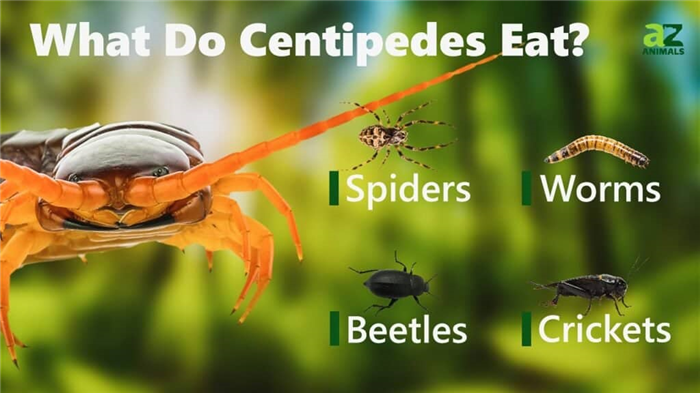
Centipedes are predators and eat a wide variety of insects and small animals.
Are Centipedes Dangerous for Humans?
Centipedes are predatory but not dangerous to humans. Their venom isn’t powerful enough to affect humans or larger animals. Still, they are not welcome everywhere. Many find their rapid movement alongside an unsettling appearance disturbing.
You can find these creatures indoors any time of year but looking to escape cold winters they sink cold winters. The animals go looking for an indoor sanctuary. The ideal place is moist and dark. A secluded space that provides food.
The creatures get in through crevices and cracks. They climb up and enter using drains. The insects immediately seclude themselves in basements, closets, bathrooms, and beneath your sinks.
Being nocturnal, centipedes are rarely seen by homeowners. When discovered, it’s usually as they scamper up a wall or along the floor.
Despite their creeping and creepy appearance, many in the insect community argue the benefits of house centipedes. They help minimize the pest populace by hunting and killing silverfish, flies, moths, roaches and termites. The centipede doesn’t create nests or webs. They’re not associated with fatal diseases or eat away at wood or other materials and gradually damages the infrastructure of your property or furnishings.
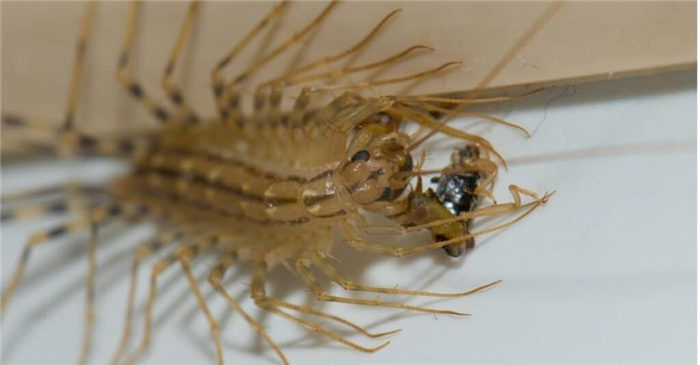
A house centipede, Scutigera coleoptrata, feeding on an earwig.
iStock.com/Víctor Suárez Naranjo
Reproduction
Solitary in nature, most species of centipede can mate without any direct contact. Males spin webs and deposit their sperm in them. Upon locating the webs, females take them and fertilize their ova. There are species of centipede that do have courtship rituals.
Outdoor centipedes set up reproduction shop in soil. Egg-laying happens throughout the spring and summer, especially in temperate areas. In tropical and subtropical areas, many eggs are laid at any given time. Indoors, the centipede looks for the usual moist, dark spaces.
When the eggs hatch, you get miniature adult centipedes. Most only have a fraction of their leg sets. The majority of their limbs will come in after a series of molts.
Getting Their Diet On
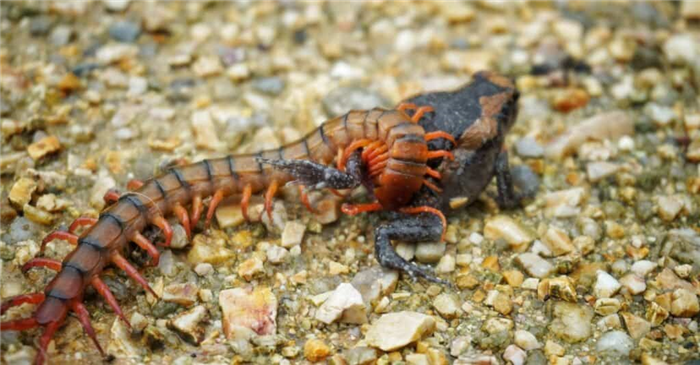
A giant Centipede bites a bullfrog on the ground.
Centipedes have very poor vision. They’re able to locate prey with their antennae. When prey closes in, the insect uses speed to race over and capture. They immediately attack, injecting the prey with paralyzing venom. The act’s conducted via claws on the creature’s first body segment.
With its prey subdued, the centipede passes its capture to its mandibles, chewing and consuming prey.
The centipede is a nocturnal and carnivorous predator. For its diet, the creature goes after small animals and insects. Here is a shortlist of the insect’s potential prey.
Carnivorous centipedes also tend to be cannibalistic, not hesitate to eat their own kind, especially if they are injured in some way. The characteristic stems from the creature’s being naturally solitary and extremely antisocial. Though you can find centipedes living in groups, the animals tend to become violent around other centipedes.
How is a Centipede’s Diet Helpful?
Centipedes are omnivorous and active hunters. There isn’t much else they do except spend every moment of their life looking for food. They tend to munch on critters we pretty much don’t want around. That’s various insects and spiders, and other small invertebrates. Larger centipedes will attack and eat vertebrates like lizards.
Predators
Centipedes are easy prey to badgers, wasps, shrews, toads, birds and chickens. Other animals on the prey list include ants, spiders and ground beetles. The centipede also has a taste for smaller snakes.
When not hunting, centipedes are in hiding, avoiding their predators. Underneath rocks are one of their favorite places. They also like piles of dead leaves and digging into the soil. They use speed to their advantage as well, as many creatures cannot keep up with them. And, of course, they’ll use their venom to paralyze a predator given the opportunity.
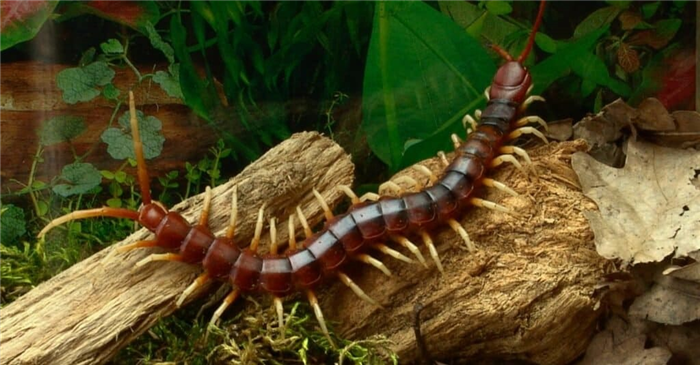
An Amazonian giant centipede Scolopendra gigantea in a terrarium.
Getting Rid of Centipedes
Despite hearing all the benefits of having centipedes around, we haven’t found anyone who’s ready to make the centipede members of the family. Here are natural ways to combat a centipede population.
- The only real way to get rid of carnivorous centipedes is to eliminate the food sources they eat. Without household pests to feed on, centipedes will look elsewhere.
- You might have excess moisture in the walls. Use a dehumidifier to remove moisture or put a fan in the bathroom.
- Go through the house and seal cracks and gaps. Not only do centipedes (and other unwanted insects) use them to get in, they also use those spaces to keep their lineage going.
- Clear your environments of debris that creates unnecessary moisture that may leak into the walls.
- Outdoors, remove compost, wood, junk and leaf piles.
- Remove any bodies of water, apply door sweeps and trim around plants.
- Use well-insulated windows and doors.
- Hire a professional exterminator.
Share this post on:
AZ Animals Staff
AZ Animals is a growing team of animals experts, researchers, farmers, conservationists, writers, editors, and — of course — pet owners who have come together to help you better understand the animal kingdom and how we interact.
What Do Centipedes Eat? What Food Lures Them to Our Houses?
Centipedes aren’t exactly recluses. These seemingly hundred-legged invertebrates will frequently visit homes at the slightest opportunity, primarily to seek food.
Now you may wonder, what grub attracts centipedes to your house? This question is interesting since centipedes are pretty shy feeders. Centipedes prefer to have their dinner when no one is watching or threatening to squish them to death.
This article reveals the nutritional requirements and habits of centipedes. Apart from answering the pending question “what do centipedes eat?” we’ll be performing a quick general outlook on these creepy creatures with multiple legs to gain a better understanding of them.
A Quick Overview of Centipedes: What Are Centipedes?
Centipedes (Latin; hundred-footed) are venomous, nocturnal, predatory arthropods of Chilopoda. Chilopoda is a subphylum of Myriapoda, a larger arthropod group that includes invertebrates, such as millipedes and other creatures with multiple legs.
Centipedes are extended metameric invertebrates with a pair of legs per body segment.
Quick fun fact — did you know that, contrary to what their name suggests, no centipede has a hundred legs precisely?
Their legs range from 30–354 in number. More interestingly, centipedes always have an odd number of leg pairs.
Furthermore, the size of these creatures can range from a few millimeters to about 30 centimeters. They usually have a dull coloration of red and brown shades. However, species inhabiting tropical areas, such as scolopendromorphs, possess bright aposematic colors, which serve to repel or warn predators.
The fossil record of centipedes suggests that the creatures evolved about 430 million years ago in the Late Silurian period. Today, approximately 8,000 species of centipedes occupying a wide geographical range are believed to exist.
Centipedes are reputable as one of the largest terrestrial invertebrate predators. Hence, they contribute significantly to the terrestrial predatory invertebrate biomass. This fact indicates why it’s critical to study centipedes’ nutritional requirements and habits.
Orders of Centipedes
Several centipede orders exist in nature. The most diverse centipede orders include:
- Scutigeromorpha — House Centipedes
- Lithobiomorpha — Stone Centipedes
- Scolopendromorpha — Tropical Centipedes
- Geophilomorpha — Soil Centipedes
Habitats of Centipedes
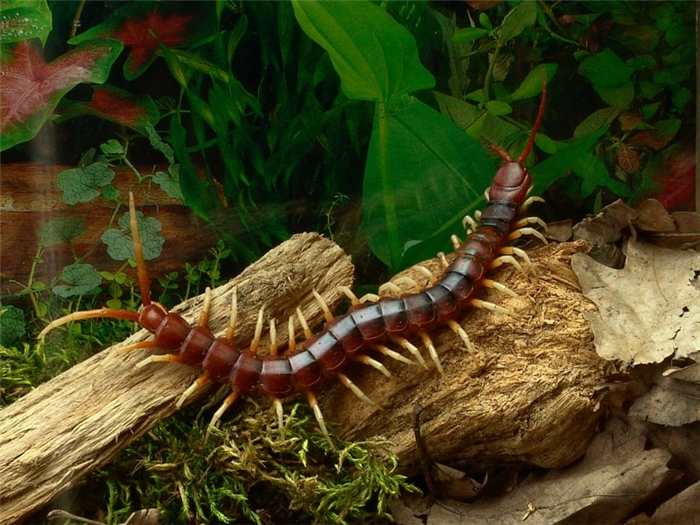
Coachella Valley Preserve
When answering the question “what do centipedes eat?” it’s vital to run through the habitat of centipedes. This is simply because an organism’s choice of food depends on its habitat, and conversely, nutrition enables organisms to survive in their chosen habitat.
In this light, centipedes’ natural habitat range extends from tropical rainforests to deserts
The alternative names of the popular centipede orders give a hint as to where a particular centipede order is found. For instance, house centipedes can be found in human households, and stone centipedes are typically located around stones. Additionally, tropical centipedes inhabit tropical regions, and soil centipedes are found on or within soil layers.
Besides food, one essential factor that influences centipedes’ habitat choice is the habitat’s water content. Centipedes lack the waxy cuticle possessed by insects and arachnids.
This deprivation causes them to lose water rapidly. Thus, they require moist microhabitats to compensate for their constant water loss.
This begs the question, how do some centipede species thrive in the desert? The answer is simple — desert centipedes are better adapted to inhabit deserts in both their anatomical structure and behavior.
Nutrition of Centipedes
Generally, centipedes are primarily carnivorous. Their diet consists of insects, spiders, other invertebrates, other centipedes, and small vertebrates on some occasions.
For optimal comprehension, we’ll be providing explanations and answers to the nutrition mode of each centipede order mentioned above.
1. Scutigeromorphs (House Centipedes)
House centipedes are perhaps one of the most frightening visitors that you may find in your homes. They may even be found underneath your wet bathroom foot mat.
You could also see them quietly crawling on a damp area below your kitchen sink. Of course, you should be able to tell why they’re in these moist regions of your house by now.
So, what nourishment brings these many-legged, unwelcome guests to your house? In other words, what do house centipedes eat?
House centipedes feed on various household insects. They have a robust appetite for cockroaches, flies, crickets, moths, small spiders, ants and silverfish.
If you once questioned the possibility that roaches could be a centipede’s favorite food, well, clear your doubts because centipedes eat cockroaches at the drop of a hat.
2. Lithobiomorphs (Stone Centipedes)
Stone centipedes live their life around stones, especially moist stones. This order of centipedes will carry out their activities outdoors preferably without coming indoors.
Lithobiomorphs are opportunistic predators and feed on any invertebrate prey of reasonable size. These creatures eat beetles, ticks, mites, mosquitoes, flies, dragonflies, and other centipedes.
3. Scolopendromorphs (Tropical Centipedes)
Tropical centipedes are the largest known order of centipedes. The subset, Amazonian Giant Centipede (Scolopendra gigantea), is the largest existing centipede species. Surprisingly, Amazonian giant centipedes may exceed 30 centimeters (12 inches) in length.
Tropical centipedes are also known as “bark centipedes” since they mostly occupy tree barks.
As expected from their relatively large size, tropical centipedes, including the Amazonian giant centipede, are impressive and fierce hunters.
Have you ever heard of centipedes that eat bats? Giant centipedes exhibit an incredible ability – they catch bats and birds in mid-flight and have them for dinner.
Again, it may be difficult for many to imagine centipedes eating mice. Still, tropical centipedes eat mice, other rodents, lizards, and frogs.
4. Geophilomorphs (Soil Centipedes)
Soil centipedes dwell in the soil. These multi-legged earth-dwellers have a method of burrowing into the ground reminiscent of earthworms (What do earthworms eat). They dig into the earth by alternately expanding and contracting their body.
Furthermore, soil centipedes live in relative proximity to plant roots. This penchant may lead novices to assume that soil centipedes eat plants.
So, do centipedes eat plants? No, they don’t feed on plants. Neither are they harmful to plants.
On the contrary, geophilomorphs protect plants by eating insects and other small creatures in the soil that may ravage plants. Beneficial, right?
Thus, soil centipedes have a different diet from their far cousins, millipedes. It’s common to see millipedes eating strawberries, tomatoes, and other ripe fruits within cracks in the soil.
Adaptations and Characteristics That Facilitate the Nutritional Mode of Centipedes
As invertebrate carnivores, several structures and behaviors enable centipedes to feed. These nutritional apparatus are the products of adaptation and evolution.
Some of these features include:
1. Forcipules
Forcipules are pincer-like modifications of the first pair of legs (maxillipeds) of centipedes. This unique structure found only in centipedes is an adaptation for hunting.
Centipedes use their forcipules to inject venom into their prey, paralysing them in the process, and enabling centipedes to keep their grip on the prey. Various species of centipedes have distinctly different forcipules. However, the structures have similar functions.
2. Antennae
Numerous centipede species lack eyes. However, some species possess compound eyes, which allow them to distinguish between light and darkness rather than see the world as we do.
One may mull over how these multi-legged creatures compensate for their “blindness.” The solution for their sight deficit lies in their antennae.
Typically, centipedes have a pair of antennae at the forward margin of their flattened or round head. They use this structure to sense and locate their prey. More importantly, their antennae are so effective that they can successfully find their target without exposing themselves to predators.
Furthermore, some groups of centipedes possess unusual sense organs, the organ of Tömösváry, found below the base of the antennae. These organs are used for sensing vibrations.
3. Venom
Venom plays a significant role in the survival of a centipede. Centipedes use their venom to incapacitate and capture prey and defend themselves against predators.
Accordingly, they secrete their venom from venom glands connected to their forcipules through a tube. The venom flows specifically through a pore located near the tip of each forcipule. This method of venom injection, through a modified pair of walking legs, is unusual in the animal kingdom.
Furthermore, the venom of a centipede constitutes a mixture of various toxins. Similar to the venoms of snakes and scorpions, centipede venom is thought to be a natural pool of proteins, peptides, and biologically active enzymes. Additionally, some contemporary pieces of research hint at the presence of more than 500 proteins and peptides in their venom.
Neurotoxic proteins and peptides are the primary active components that rapidly paralyze prey.
4. Digestive Tract
The digestive tract has been adjusted structurally over years and generations to enhance the assimilation of nutrition. Fundamentally, the digestive tract of a centipede is a simple tube with digestive glands attached to the mouthparts.
5. Nocturnality
Due to their poor vision, centipedes prefer hunting at night when they have the upper hand. Their antennae enable them to maneuver handily in the dark and locate their unsuspecting prey.
6. Speed and Agility
Other elements employed by centipedes when hunting are speed and agility. They move considerably fast and attack their prey energetically, enhancing their hunting success. These traits also enable centipedes to evade potential dangers.
Nutrition of Young Centipedes
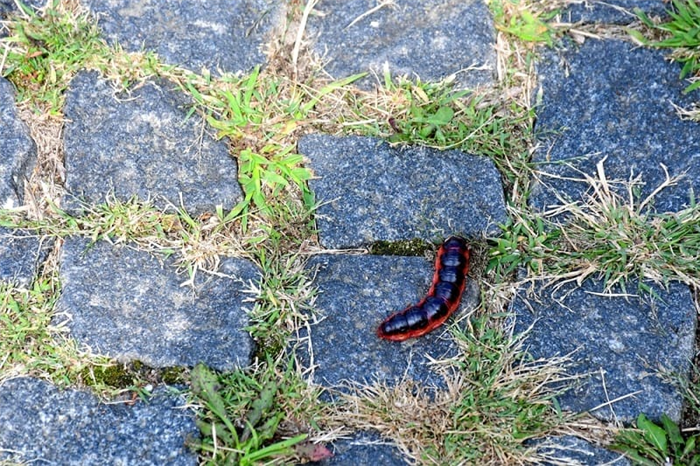
Coachella Valley Preserve
Some animals have different diets at various stages of their life. What about centipedes? What do baby centipedes eat?
Centipedes usually emerge from eggs after a female centipede has engulfed a spermatophore deposited by a male centipede.
After hatching, the young centipedes consume small insects, such as fruit flies, carpet beetle larvae, and small crickets.
Some centipede species exhibit a more startling nutrition mode when they’re newly hatched. In some species of scolopendromorpha (tropical centipedes), matriphagy occurs — where the offspring eat their mother.
Centipedes Versus Spiders
The nutrition war between these two arthropods is worthy of special mention. While both centipedes and spiders equally share a craving for eating insects, what happens when no insects are around, and the two carnivorous invertebrates cross paths? Do centipedes eat spiders, or do spiders eat centipedes?
These questions get two positive responses. Yes, centipedes eat spiders and even present a means of keeping spiders away. Nonetheless, spiders also eat centipedes only when they have an advantage over centipedes, for instance when staged against young centipedes.
The Danger Myth of Centipedes
Contrary to popular belief, centipedes aren’t dangerous to humans if left alone. These multi-legged arthropods are only threatened to attack humans when disturbed or provoked as a defensive mechanism. In such cases, they react by biting humans and injecting them with their venom.
Even so, centipede venom doesn’t typically cause any severe or fatal damage to humans. The bites may be painful and stimulate allergic reactions in some individuals, but they’re usually not deadly.
Relevance of Centipedes to Humans in Terms of Nutrition
Centipedes and humans are two organisms that regularly interact with each other. Hence, however different they may look, both creatures are relevant to one another nutritionally.
1. Natural Form of Pest Control
The nutritional characteristics of centipedes, especially house centipedes, tends to reduce the number of insect pests in our homes. While centipedes benefit from munching on some insects, such as ants, roaches, flies, bedbugs and tiny spiders, we profit from the population reduction of these pests.
Yet, centipedes’ control doesn’t provide optimal solutions due to insects’ rapid and multiple reproductions.
2. Source of Food for Humans
Farmed giant centipedes are prepared and eaten as food by some humans, especially people in China, Thailand and Vietnam. The centipede meal is usually prepared after the heads and pincers of the centipedes have been taken off.
One may wonder if centipedes are poisonous to eat. The truth is, if properly prepared, the dish isn’t harmful to humans.
3. Study of Centipedes’ Nutritional requirements and Habits
As suggested by this article, many scientists are interested in studying centipedes’ nutritional requirements and habits. Since centipedes may be forced to eat their meals in the dark, the topic of their nutrition is particularly fascinating.
An individual who frequently sees house centipedes in their home but hasn’t observed the predatory nature of centipedes may ask, ” do centipedes eat human food?”. It is known that this isn’t always the case.
Bottom Line
The nutritional requirements and habits of centipedes are fascinating contrary to the popular belief that centipedes are boring animals. We hope you have become more aware of the different sorts of prey preferred by the various orders and stages of centipedes.
Most importantly, we hope we have helped you to understand that centipedes are more in the category of natural pest controllers rather than pests themselves.
What Do Centipedes Eat?
Centipedes are nocturnal predators of insects and other small animals. A short list of possible prey includes:
Centipedes have poor vision but are able to find prey by using their antennae. Once suitable prey is located, they use their quick speed to capture, bite, and inject their prey with paralyzing venom. The bite and delivery of venom is by a pair of claws located on the centipede’s first body segment.
Once subdued, the prey is passed to the centipede’s mouth where mandibles (teeth) enable them to chew up and consume the prey. Although there’s a possibility centipedes could bite a homeowner or pet, they are generally considered beneficial since they help control other pest populations.
What Do House Centipedes Eat?
House centipedes are terrifying to unexpectedly find when moving a shoe, but these little pests offer little danger to humans. They are, however, prestigious hunters and love to clear homes of other creepy crawlies that may be present. Venomous and quick, house centipedes have a varied diet that reflects their hunting prowess. Let’s take a look at these interesting bugs and learn what house centipedes eat.

Centipedes are predators and eat a wide variety of insects and small animals.
House centipedes are insectivores that primarily eat insects like cockroaches, flies, moths, and crickets.
While humans don’t think of centipedes as hunters, that description seems to fit these quick and insectivorous insects perfectly. An insectivore is simply a carnivorous plant or animal that eats insects as its primary food source. All centipedes are arthropods, and house centipedes almost exclusively eat other arthropods.
When it comes to their favorite foods, house centipedes will eat nearly any insect they are large enough to kill. Considered pests themselves, they differentiate themselves from other house pests by eating them, forming a sort of “natural” pest control. They eat cockroaches, flies, moths, crickets, silverfish, spiders, and even wasps.
Many people dislike the sight of house centipedes (they seem to prefer running at people’s feet) and often have them removed professionally. Still, these stubborn insects may provide some utility to a home or yard by way of their diets.
A complete list of foods house centipedes eat
House centipedes eat:
- cockroaches
- flies
- moths
- crickets
- earwigs
- spiders
- wasps
- hornets
- ants
- earthworms
- slugs
- snails
How do house centipedes hunt?
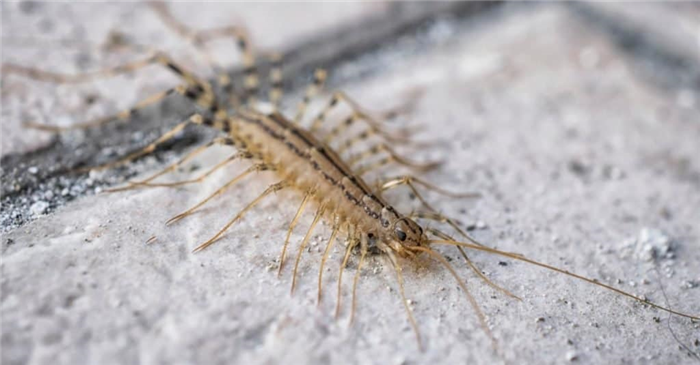
House centipedes inject their prey with venom before they eat them.
Almost all centipedes are venomous; the house centipede included. These insects have 15 pairs of legs and are extremely fast. On average, house centipedes can move at 1-foot a second. With their speed and their venom, they are able to take down prey that is significantly larger than they are.
Typically, house centipedes hide during the day and come out at night to hunt. Although they have eyes, they mostly use their antennae for hunting. Their antennae can smell and feel, helping more than eyes would in dark spaces. When they spot potential prey, they quickly move up and grab it within their legs. Once they have their prey firmly caught, they strike with their modified front legs known as forcipules (essentially fangs) and inject their venom.
Centipedes often use a technique known as “lassoing” to trap their prey within their legs like a rope. This lassoing effect can be seen easier with larger spaces, particularly when they are hunting larger prey like mice and lizards. Their venom usually kills their prey but has a mild response in humans.
Although we wouldn’t think of house centipedes as “smart,” they have developed special hunting strategies for various types of prey. When a centipede hunts wasps, for example, they will quickly get in range to inject their venom and then back away. Once it’s clear that the wasp has died, they will move in to finally eat. For insects that aren’t a threat to them, this behavior doesn’t occur.
Where do house centipedes live?

Incredible hunters, house centipedes can kill and eat almost any arthropod.
iStock.com/Víctor Suárez Naranjo
House centipedes originated in the Mediterranean but eventually spread to the rest of the world.
When living outdoors, they prefer cooler, damp places. They need moist areas that keep them from dehydrating and can be found under rocks, piles of wood, and leaves.
They also live in proximity to humans, namely, in their homes. Most people have encountered one or two in their lifetime, and it often happens in the bathroom. Since they prefer dark and moist environments, bathrooms, basements, and garages are usually the most common places to find them. During the colder months, they will seek shelter in warm human homes, increasing sightings.
They often breed in the baseboards or dark places in homes and lay up to 150 eggs at a time. Although they are terrifying to stumble upon, they aren’t usually seen unless they are stuck in a bathtub or sink since they are nocturnal.
Should you kill house centipedes when you find them?
Although house centipedes are true pests, is it worth it to kill them? There are competing beliefs when it comes to their extermination, so we will lay out a few of the best points from both sides.
When it comes to keeping house centipedes alive, the biggest argument resides in their ability to act as natural pest reducers. They are always looking for food and regularly attack and kill other pests that humans don’t want in their houses. If you have house centipedes, it likely means that you also have some other nasty pests making their home in yours. Additionally, when an area has been removed of arthropods, centipedes will move on and leave home. If you want a “natural” form of pest control, not extermination, these insects may be a decent option. Unlike millipedes, centipedes don’t potentially cause structural damage and can also kill insects who would (termites and millipedes). At a minimum, repeatedly seeing house centipedes in your home is a great sign to call an exterminator. It means there are likely other bugs you need to deal with.
On the other side of things, house centipedes are pests themselves and have bitten humans before. Although it’s rare, house centipedes will bite if they are handled roughly or trapped and prodded. If bitten, it takes the form of a very mild bee sting, and most people would consider it mildly painful. Most of the time they aren’t even able to get their “fangs” through a human’s relatively thick skin. In addition to the “bite potential,” some people don’t like the idea of having bugs living in their home, no matter how beneficial they may be.
Primary Sidebar
Recent Posts
- How to Get Rid of Fleas in a Car
- How to Get Rid of Fleas on Humans Hair
- How to Get Rid of Mice Urine Odor: 5 Effective Ways
- What Do Crane Flies Eat?
- Why Do I Have Ants in My Bathroom?
Important Legal Information
This site is owned and operated by Muller Media LLC. Muller Media LLC is a participant in the Amazon Services LLC Associates Program, an affiliate advertising program designed to provide a means for sites to earn advertising fees by advertising and linking to Amazon.com. Muller Media LLC also participates in affiliate programs with Bluehost, Clickbank, CJ, ShareASale, and other sites. Muller Media LLC is compensated for referring traffic and business to these companies.
